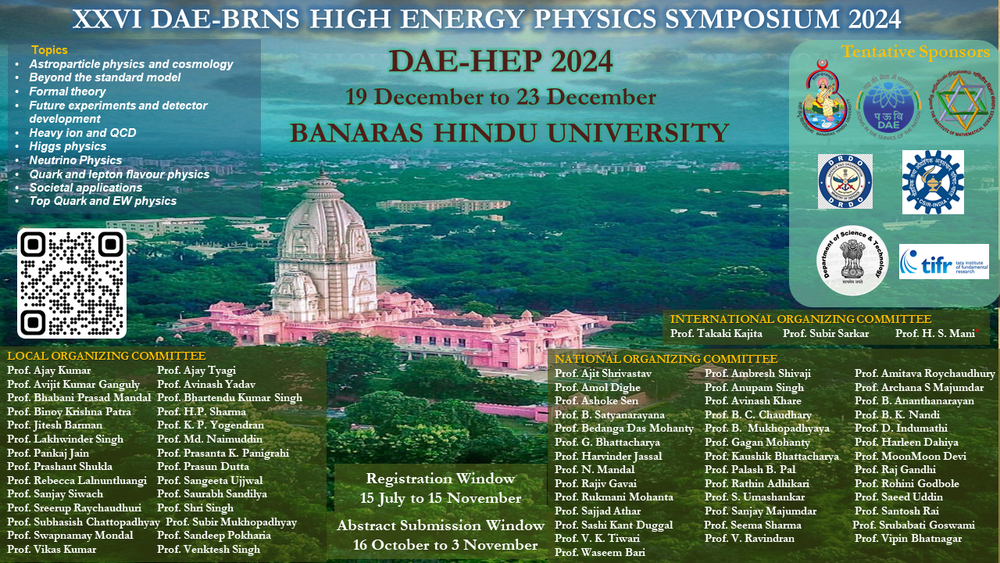Speaker
Description
Baryonic decays which involve $b→d$ are very sensitive to new physics effects. Recent experimental observations of $\Lambda_b^0→pK^- \mu^+ \mu^-$ decay motivate the theorist to study baryonic decay [1]. The $\Lambda_b→nl^+ l^-$ decays are forbidden at the tree level in SM. It provides opportunities to test NP models like the leptoquark model [2], two-Higgs doublet model (2HDM) [3], non-universal $Z'$ model [4] and fermion fourth generation model [5]. In the theoretical background, many attempts have been made in different approaches like light cone sum rule (LCSR), lattice quantum chromodynamics (LQCD), the 2HDM and the Bethe-Salpeter equation approach. In the Bethe-Salpeter equation approach the obtained branching ratios $Br(\Lambda_b→nl^+ l^- )×10^8$ are $6.79^{+8.66}_{-1.82}$ (for $l=e$), $4.08^{+5.44}_{-1.19}$ (for $l=μ$) and $(2.9)^{+3.7}_{-0.78}$ (for $l=τ$) [6]. In the context of LQCD and LCSR [7] branching ratios $Br(\Lambda_b→nl^+ l^- )×10^8$ are obtained as (3.19±0.32),(3.79±0.46) (for $l=e$), (3.15±0.29),(3.76±0.42) (for $l=μ$) and (1.42±0.32),(1.65±0.19) (for $l=τ$) respectively. Later on these results are updated in LCSR [8] $Br(\Lambda_b→nl^+ l^- )×10^8$ as (8±2) (for $l=e$), (7±2) (for $l=μ$) and (2±0.4) (for $l=τ$). In the relativistic quark-diquark model of baryons, the branching ratios $Br(\Lambda_b→nl^+ l^- )×10^8$ are 3.81 (for $l=e$), 3.75 (for $l=μ$) and 1.21 (for $l=τ$) [9]. In this work, we intend to study $\Lambda_b→nl^+ l^-$ decays in non-universal $Z^{'}$ model. We will estimate the transverse polarization asymmetry for $\Lambda_b→nl^+ l^-$ decays. To determine new physics, we will use quark coupling from $B_d^0-B ̅_d^0$ mixing. We hope these results will help the experimental community to explore these kinds of decays at the LHCb/Belle II detector in the upcoming time.
Acknowledgement
R. Ray acknowledges DST, Govt. of India for providing the INSPIRE Fellowship (IF210427) during his research.
References
1. R. Aaij et al. (LHCb Collaboration), JHEP 05, 05 (2020).
2. M. Schmaltz and Y.M. Zhong, JHEP 01, 132 (2019).
3. H. B. Maïto, A. Falkowski, D. Fontes, J.C. Romao and J. P. Silva, Eur. Phys. J. C 77, 176 (2017).
4. P. Langacker, Rev. Mod. Phys. 81, 1199 (2009).
5. R. Mohanta and A. K. Giri, Phys. Rev. D 85, 014008 (2012).
6. L. L. Liu, C. Wang, X. Kang and X. H. Guo, Eur. Phys. J. C 80, 193 (2020).
7. K. Azizi, M. Bayar, Y. Sarac and H. Sundu, J. Phys. G: Nucl. Part. Phys. 37, 115007 (2010).
8. T. M. Aliev, T. Barakat and M. Savcı, Phys. Rev. D 98, 035033 (2018).
9. R. N. Faustov and V.O. Galkin, Mod. Phys. Lett. A 32, 1750125 (2017).
| Field of contribution | Phenomenology |
|---|

